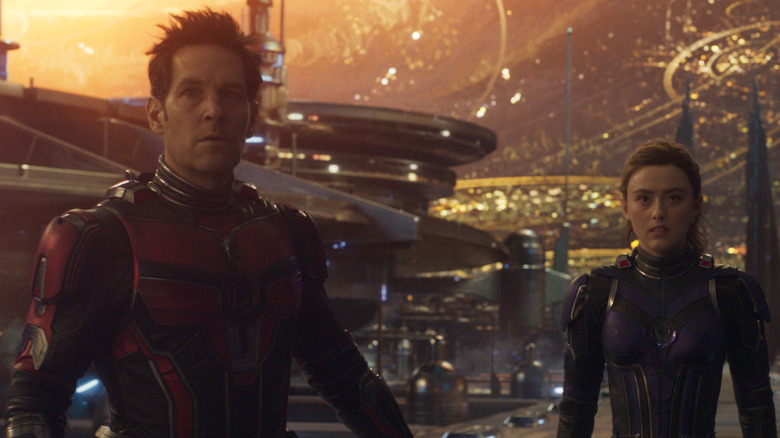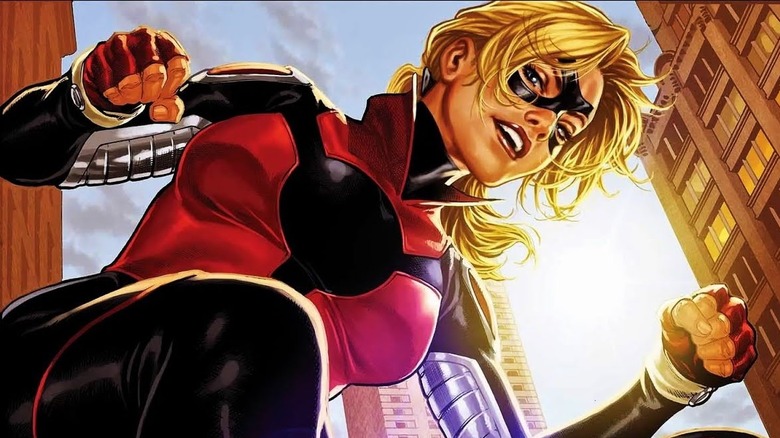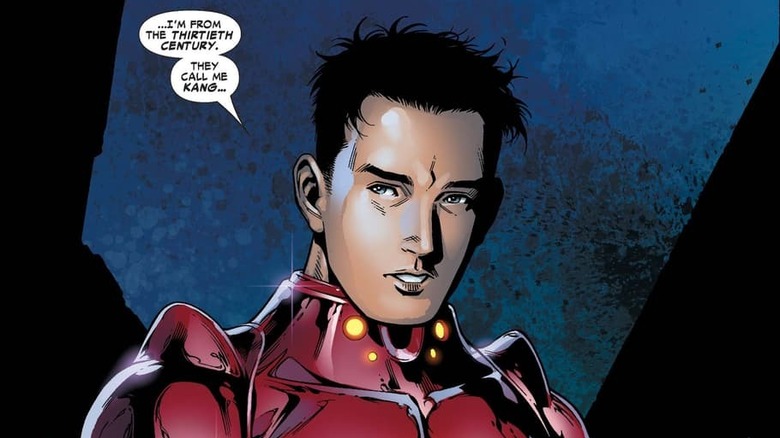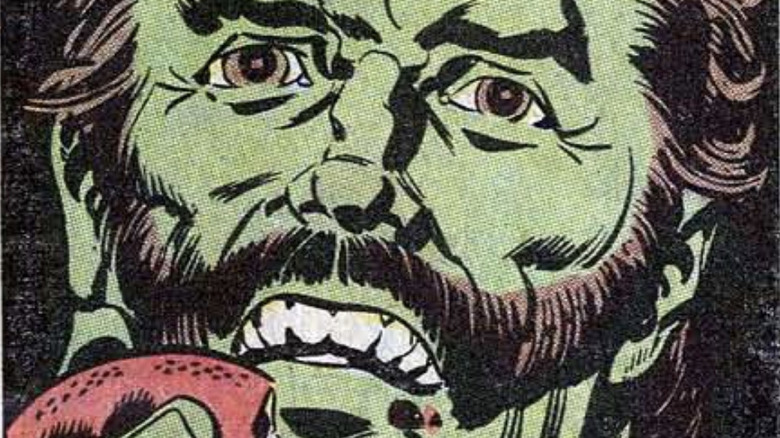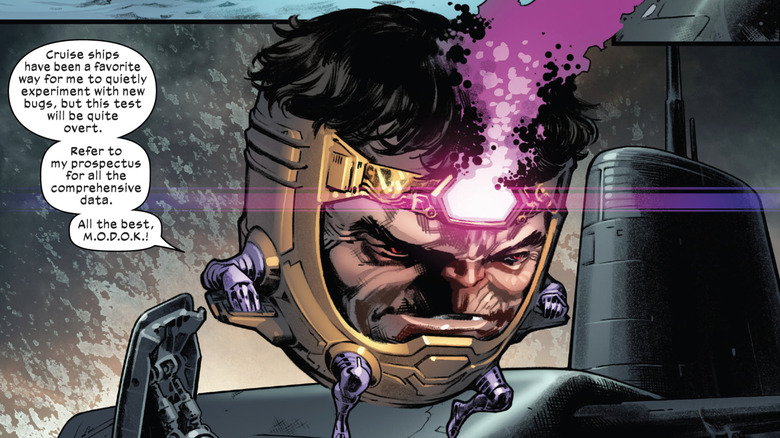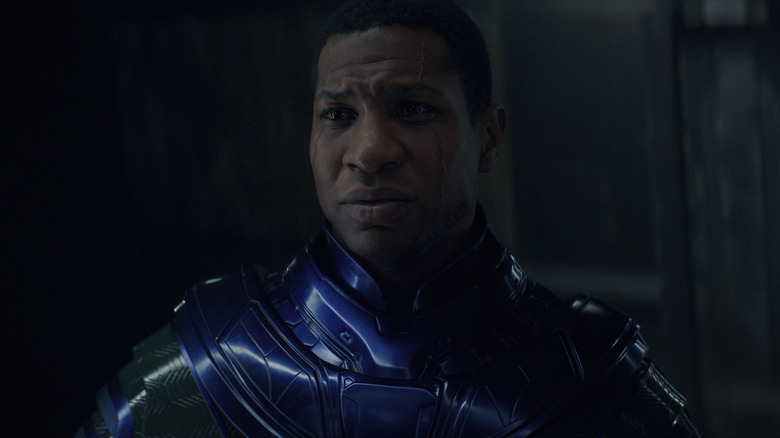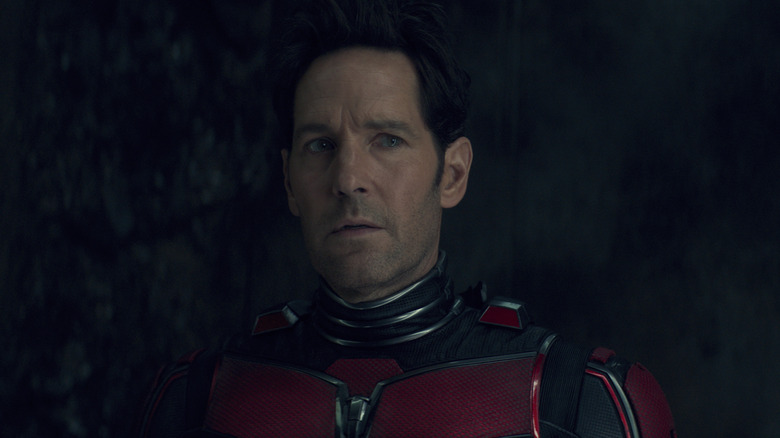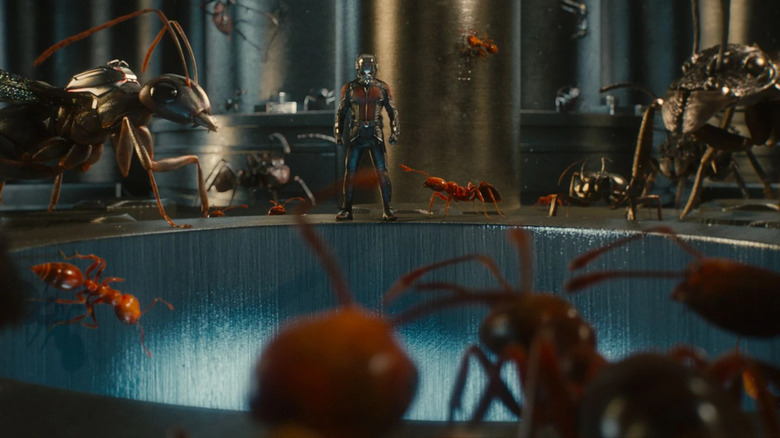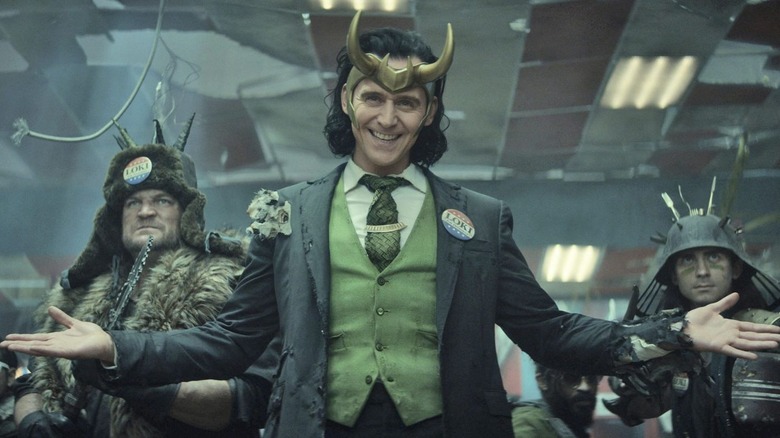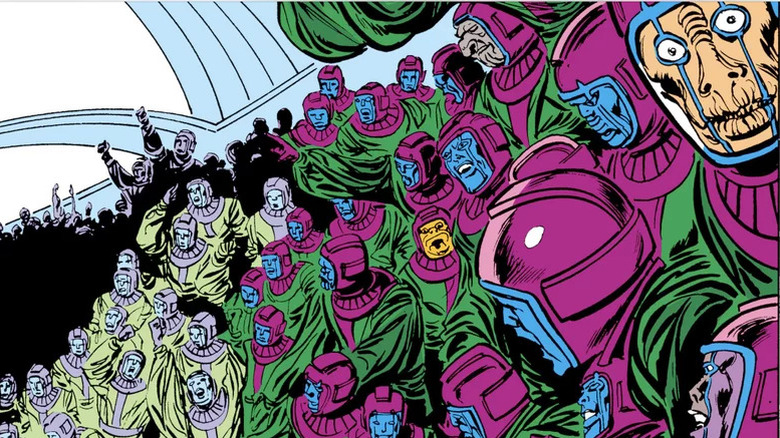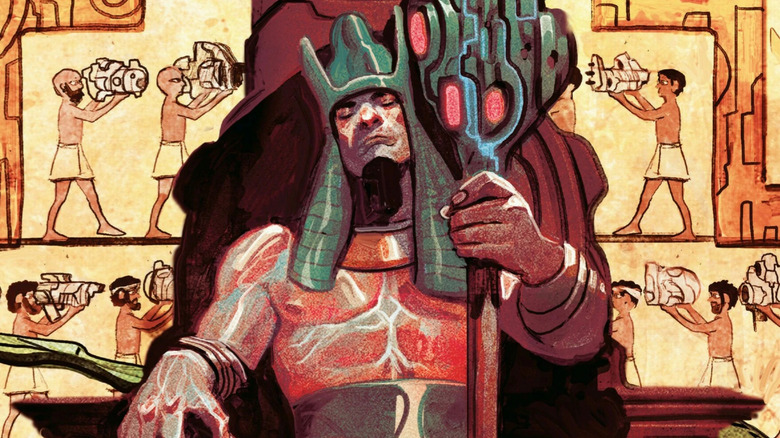Characters In Ant-Man And The Wasp: Quantumania Who Mean More Than You Think
With the release of "Ant-Man and the Wasp: Quantumania," the Marvel Cinematic Universe has officially gone quantum, which seems to mean absolutely bonkers. The movie is a wild journey through the bizarre and unceasingly comical Quantum Realm, a dimension free from the shackles of space, time, and consistent tone. Everything about the film is a lot, and whether you love it or hate it (and based on its divisive reactions, chances are it's one of those two), you can't deny that it offers plenty to unpack. On top of all the kaleidoscopic visuals, lava lamp vistas, and repeated iterations of the "Star Wars" cantina scene, the film also contains its share of easter eggs and deep-cut characters with more to them than you might think.
After the mega-success of "Avengers: Endgame" brought the Infinity Saga to a thorough close, it seemed like the main goal for the MCU's Phase Four has been to introduce as many new characters to the universe as possible. Even though it actually kicks off Phase Five, "Ant-Man and the Wasp: Quantumania" certainly keeps the trend alive, introducing a quantum ton of new characters, many of whom have histories in Marvel comics and potentially even more of them with big futures in upcoming movies. Among the Giant-Man-sized cast in "Ant-Man and the Wasp: Quantumania," here are our picks for the characters who we bet mean more than you think.
Cassie Lang
Since the MCU began, fans have speculated about a potential movie starring the Young Avengers, Marvel's foremost team of teen and 20-something heroes. Nearly every main and founding member from the comics has made their way onto the big screen at some point — whether as their heroic persona or simply their civilian identity. Arguably the first to appear was a young Cassie Lang back in 2015's "Ant-Man." With "Ant-Man and the Wasp: Quantumania," she has finally donned her suit and begun growing to colossal sizes in order to protect the innocent. In short (pun intended), the MCU now has its Stature (Kathryn Newton).
In the comics, Lang aka Stature has been a founding member of the Young Avengers and a full-fledged Avenger, both as part of Captain America's Secret Avengers and Hank Pym's Mighty Avengers. In other words, she's been a major player since her costumed debut in 2005's "Young Avengers #4" and with her MCU debut now complete, she is poised to be a major player on screen, as well.
With Stature firmly in hand, the only founding Young Avenger left to appear in the MCU is Teddy Altman, aka Hulkling. As a half-Kree-/half-Skrull (and despite his name, not a Hulk at all), Hulkling has a couple of convenient possible introduction points in 2023's "Secret Invasion" and "The Marvels."
Iron Lad
On the one hand, saying that the MCU now only needs its Hulkling to round out its core Young Avengers team is completely accurate — every member but Altman is accounted for. On the other hand, the statement is somewhat of a lie, given that the MCU has never introduced its Iron Lad. On the other, other hand, the character has been introduced due to the fact that Iron Lad is actually just a young, time-displaced version of Kang the Conqueror. If that sounds confusing, that's because it is, but there's no escaping that sort of alternate-self, time-travel mumbo jumbo when it comes to Kang — and we're in for a lot more Kang (Jonathan Majors) over the next few years.
When the Young Avengers first formed, each styled themselves after a famous Avenger: Hulking after the Hulk, Asgardian after Thor, Patriot after Captain America, Stature after Ant-Man and Giant-Man, Hawkeye after Hawkeye (obviously), and Iron Lad after Iron Man. Though most of these early identities would give way to more individualistic alter egos as time progressed (for example, Asgardian becoming Wiccan, a more honest title for the magically-gifted son of the Scarlet Witch), none would change as much as Iron Lad.
Despite earnest efforts to alter his destiny and avoid becoming a despotic tyrant, Iron Lad succumbs to the inevitability of his timeline. He eventually grows into the Prime Kang, Kang the Conqueror, making him both a founding Young Avenger and one of their greatest villains, oddly enough.
Krylar
With over 60 years as a publisher, Marvel has created an unimaginably vast pool of source material from which to draw — over 27,000 comics — and the MCU has dipped into it deeply in the past. For Bill Murray's character Krylar in "Ant-Man and the Wasp: Quantumania," however, they may have dug deeper than ever before, as in one-comic-appearance-ever deep.
There is indeed a Lord Krylar in the comic book universe, or rather there was, as his one appearance before his near-immediate death came in 1972's "Incredible Hulk #156." Interestingly, Krylar lived on K'ai, a planet contained within the Microverse, Marvel comics' predecessor to the MCU's Quantum Realm. The likely implication of Krylar's inclusion in the MCU, therefore, is that writer Jeff Loveness and or director Peyton Reed scoured the comic book backlog for any mention of the Microverse and its inhabitants, no matter how small (pun intended again).
Though Krylar's role in Hulk's story is brief — merely a K'ai military commander caught in the planet's political conflict — he did appear in conjunction with a major Hulk character, Jarella. Jarella, the green-skinned princess of K'ai, was one of the Hulk's greatest (and only) love interests. She kept the hero emotionally connected to the Microverse, and she could very well do the same for our MCU Hulk (Mark Ruffalo) in the future, especially since he already began experimenting with the Quantum Realm in "Avengers: Endgame."
MODOK
As one of Marvel's most recurrent and beloved villains, MODOK was virtually guaranteed to rear his oversized head in the MCU at some point or another. Fans may logically have expected him to appear alongside longtime minions AIM in "Iron Man 3" or at some point in one of the Avengers movies. Yet the MCU found a strange, new avenue to introduce the infamous villain — resurrecting original "Ant-Man" villain Darren Cross in the floating chair only to kill him in the same movie — and it belies the character's true significance to Marvel canon.
Unlike the MCU's MODOK, his comic book counterpart is truly an Avengers-level threat, a super-genius (you'd have to be with that colossal cranium) whose mind is complemented by both a technologically advanced murder suit and an entire army of dedicated goons in AIM. The "Quantumania" MODOK is funny, and his implementation via Cross is pretty clever, but this version simply doesn't do justice to the comics' Mental Organism Designed Only for Killing who so often lives up to his name.
If we're lucky enough to see MODOK return to the MCU in the coming years (perhaps a variant portrayed by "M.O.D.O.K." voice actor Patton Oswalt), his timing would be propitious. Thaddeus Ross is returning to the MCU in a big way, and it could get even bigger — in the comics, it was MODOK who transformed Ross into the rampaging Red Hulk.
Kang
This entry is no surprise — Kang the Conqueror is potentially the single most pivotal character in the MCU going into Phases Five and Six and, depending on how effectively he emerges from Thanos' shadow, possibly the most important character in MCU history. There are any number of reasons to highlight Kang's importance, not least of which is his potential to destroy the entire MCU multiverse ahead of 2026's planned blockbuster "Avengers: Secret Wars." Yet the reason Kang in "Ant-Man and the Wasp: Quantumania" truly means more than you think comes from just one short dialogue between him and Scott Lang (Paul Rudd).
With Lang held captive in his prison, Kang interrogates the hero and tries to help him realize the futility of his resistance. When Lang attempts a meager defense by proudly proclaiming that he's an Avenger, it's no surprise that Kang is unimpressed. What is surprising, however, is Kang's explanation of why. The multiversal tyrant tells Lang that he's killed so many Avengers that he's lost track of them. Even scarier, he asks Lang "Are you the one with the hammer?" heavily implying that he's accomplished the inconceivable labor of murdering a Thor variant (or possibly Jane Foster, or even Thor's adopted daughter, Love).
The real significance of Kang's words goes even deeper, however, when you consider that Kang also revealed his ability to see the entire timeline at once. It may be (and we're betting it is) that Kang is actually "recalling" his encounter with our main Thor (Chris Hemsworth) in the future, and this is Marvel revealing the Asgardian's inevitable — and canonical — death.
Ant-Man
There is a very good chance that MCU Phases Five and Six will play out very differently than the first four, and "Ant-Man and the Wasp: Quantumania" raises that chance immensely. Aside from upping the ante from one universe at stake to countless thousands of them, the movie also makes it doubly clear that some new heroes will be taking charge in the fight against Kang. First to move up to the center stage is Ant-Man himself, the first and only character known to defeat a variant of Kang (with the possible exception, depending on your perspective, of Sylvie who fatally stabbed He Who Remains).
Throughout the first three MCU phases, it was obvious which heroes were in charge — Iron Man (Robert Downey Jr.), Captain America (Chris Evans), and Thor ran the show, hence why their names still pop up in every other MCU project to this day. As of "Quantumania," two of them are gone and the third had his death foretold by Kang. Phases Five and Six are due for a new team of Avengers with new leadership, and in killing a main Kang variant, Lang is now the most qualified. When paired with experienced Kang-hunter Loki (Tom Hiddleston, who we'll mention elsewhere in the article), Lang may soon find himself co-leading the multiversal war on Kang.
The ants
What would an Ant-Man movie be without armies of loyal, plucky ants swarming the bad guys and saving the day? In keeping with tradition, the ants are back in "Ant-Man and the Wasp: Quantumania," except that this quantum, sci-fi adventure demanded equally crazy, quantum, sci-fi, ants. Like the Quantum Realm itself, the very existence of these hyper-brainy bugs raises an incalculable amount of questions about the nature of the MCU, and though we don't quite have the PhDs in theoretical cosmology required to answer them, we can at least begin posing those questions here.
The short story is that a colony of Hank Pym's (Michael Douglas) ants has evolved super-intelligence, invented quantum tech, and colonized the Quantum Realm — and they did it all themselves. Completely unintentional on Pym's part, some of his ants were caught in a time dilation that allowed them to evolve at hyperspeed, which resulted in their superhuman intelligence. Once smart enough, the ants began producing tech, eventually reaching a sci-fi level of civilization and allowing them to defeat Kang and his armies almost on their own.
Two things strike us immediately worthy of concern. Firstly, Pym describes the ants as a "Type II Civilization," a ranking on the Kardashev scale, meaning that the ants have already harnessed the power of an entire star for their own uses. Secondly, if the ants evolved thousands to millions of years and seemingly only their brains changed, does that mean that modern ant bodies have already achieved perfect form?
Loki
We've pointed out that "Ant-Man and the Wasp: Quantumania" establishes Ant-Man as the first and only hero to defeat a Kang variant, but that doesn't mean he's alone in his fight. A post-credits scene shows us a teaser clip from (or preceding) the upcoming Season 2 of "Loki" in which Loki and Mobius (Owen Wilson) sit in a Victorian-looking theater, evidently catching the act of one Victor Timely. As it is quickly revealed, Timely is yet another variant of Kang. When Loki recognizes the variant and points him out to Mobius, it becomes clear that Loki has made it his mission to locate and likely destroy the multiverse's many Kangs. In a more meta sense, that puts Loki on track to headline the next MCU phase or two.
Given Loki's experience with Kang, his current mission, and Kang's reveal that he has killed (and maybe still will kill) Thor, Loki has all the makings of the MCU's next main character, insofar as that role exists. From the real-world side of things, the Loki character and his solo series "Loki" are exceptionally beloved by fans, as is Hiddleston himself. The actor is also committed to playing the trickster god as long as he can, and when combined with the other contributing factors, that makes Loki the most likely new lead in the MCU.
The Council of Kangs
At this point, it's reasonable to be surprised by just how many Kangs there are and how increasingly convoluted their lore has become. We might even forgive you for feeling sick of all the new variants and time-displaced alternates, except then, we wouldn't be doing our job of preparing you for the Kang-a-palooza that will be Phases Five and Six.
The reality is (or rather, the many alternate realities are) that Kang is legion — so legion, in fact, that a few thousand of his variants have banded together to form their own multiversal governing body, the Council of Kangs. One of the post-credits scenes in "Ant-Man and the Wasp: Quantumania" reveals the Council in all their purple-helmeted glory, and their existence within the MCU bodes terribly for our heroes — as well as everyone they've ever known.
The scene — pulled straight from the comics – reveals that a potentially infinite number of Kangs exist throughout the multiverse, and each seems as dangerous and maniacal as the last. What's worse is that each Kang seems just unique enough to offer their own unique twist on the default Kang's mercilessness and savagery. As fans of the comics will likely be aware, the Council of Kangs means a lot for the MCU, as they are the source of many of the timeline's worst atrocities.
Rama-Tut, Immortus, and the Scarlet Centurion
During a post-credits scene in "Ant-Man and the Wasp: Quantumania," we're given a terrifying teaser as to the true number of different Kang variants and the extent of their power. Though most of the assembled Kangs are merely hooting and hollering, slaves to their bloodlust and the promise of combat, a trio of them are shown gathering in a secret cabal to discuss more pressing matters: the exiled Kang the Conqueror, his death, and the coming multiversal war. Each of those three variants is visibly distinct from the rest, and that is for good reason. The three of them — Rama-Tut, Immortus, and (most likely) the Scarlet Centurion — are the three most recurring, memorable, and iconic Kang variants in comics history. Arguably, they're also the three deadliest.
All three are technically the same Kang, at least in a multiversal sense, as they are all the Kang from Earth-6311. However, they share almost nothing in common due to each coming from different points on the timeline, separated by tens of thousands of years. The one thing they all share is that each has spent decades in the comics defeating the Avengers, conquering the Earth, and creating multiversal empires. As of "Ant-Man and the Wasp: Quantumania," Ant-Man may have defeated a Kang variant and another few may have Loki on their tail, but no one in the MCU is even yet aware of Rama-Tut, Immortus, and the Scarlet Centurion, possibly the three most dangerous beings in existence.
